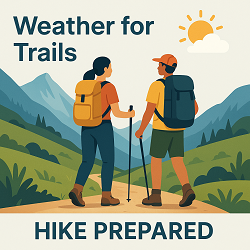Oradell, NJ Weather Forecast and Current Conditions (07649)
Current Conditions From Nearby Local Station

Feels Like 55°F
at
Current Conditions From Nearby Local Station

Feels Like 55°F
at
Point Forecast at a Glance







7-Day Temperature Trend
Week Ahead Summary
High temperatures remain relatively stable through the week, ranging from 55°F to 59°F. Some rain possible with at least 2 days showing precipitation chances of 20% or higher.
Climate Context
Temperatures are expected to be near normal for this time of year, with highs around 58°F and lows around 40°F.
This Date in Weather History
1846 - Eighty-seven pioneers were trapped by early snows in the Sierra Nevada Mountains that piled five feet deep, with 30 to 40 foot drifts. Just 47 persons survived the "Donner Pass Tragedy".
More on this and other weather history
Oradell 7 Day Weather Forecast Details
Friday Oct 31

Day: Mostly sunny. High near 58, with temperatures falling to around 55 in the afternoon. West wind around 22 mph, with gusts as high as 38 mph.

Night: Mostly clear, with a low around 43. West wind 12 to 21 mph, with gusts as high as 36 mph.
Saturday Nov 1

Day: Sunny. High near 56, with temperatures falling to around 54 in the afternoon. West wind around 12 mph, with gusts as high as 25 mph.

Night: Partly cloudy, with a low around 39. West wind 2 to 8 mph.
Sunday Nov 2

Day: Mostly sunny. High near 58, with temperatures falling to around 55 in the afternoon. West wind 2 to 6 mph.

Night: Partly cloudy, with a low around 41.
Monday Nov 3

Day: A chance of rain showers after 1pm. Partly sunny, with a high near 59. Chance of precipitation is 30%.

Night: A chance of rain showers before 1am. Partly cloudy, with a low around 45. Chance of precipitation is 40%.
Tuesday Nov 4

Day: Sunny, with a high near 58.

Night: Mostly clear, with a low around 40.
Wednesday Nov 5

Day: Mostly sunny, with a high near 58.

Night: A chance of rain showers after 7pm. Mostly cloudy, with a low around 46. Chance of precipitation is 40%.
Thursday Nov 6

Day: A chance of rain showers before 1pm. Mostly sunny, with a high near 55. Chance of precipitation is 30%.

Night: Partly cloudy, with a low around 36.
Sun & Moon Monthly
Sunrise 7:27 AM
Sunset 5:54 PM
Last Light 6:23 PM
Moonset 1:22 AM

Close Tide Stations
New Millford
(1.7 miles away)
Hackensack
(5.4 miles away)
Alpine, N.J.
(6.3 miles away)
Weather Near Oradell
Contiguous United States Extremes
Wed's High Temperature
103 at 2 Miles West Of Pala, CA
Thu's Low Temperature
12 at 4 Miles Northwest Of Grand Lake, CO and 2 Miles Southwest Of Canyon Village, WY
Weather Folklore
When frogs jump across the road, they are looking for rain.
Current subscribers - login to your ClearSky account
Warning: file_get_contents(): Unable to find the wrapper "https" - did you forget to enable it when you configured PHP? in /big/dom/weatherforyou.com/www/reports/hamlib/HW/Template.php(331) : eval()'d code on line 1
Warning: file_get_contents(https://en.wikipedia.org/w/api.php?action=query&prop=extracts&exintro&titles=Oradell%2C+New+Jersey&format=json): failed to open stream: No such file or directory in /big/dom/weatherforyou.com/www/reports/hamlib/HW/Template.php(331) : eval()'d code on line 1
Warning: reset() expects parameter 1 to be array, null given in /big/dom/weatherforyou.com/www/reports/hamlib/HW/Template.php(331) : eval()'d code on line 1
How We Provide Better Local Weather
Current conditions: We use the nearest available station to your location - including professional MESONET/MADIS and local weather stations - often miles closer than regional airports.
Forecasts: National Weather Service point forecasts predict for your specific area, not broad regional zones, making them far more relevant to your location.

